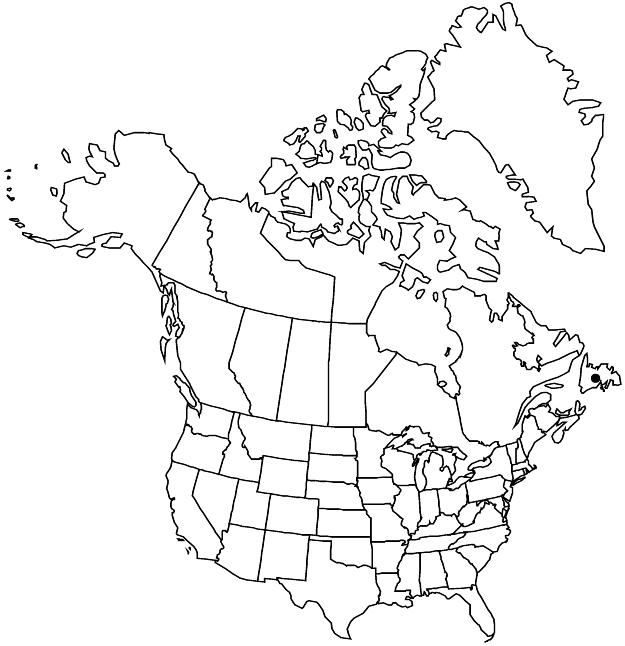Difference between revisions of "Cerastium terrae-novae"
Rhodora 22: 176. 1921.
FNA>Volume Importer |
imported>Volume Importer |
||
| (6 intermediate revisions by 2 users not shown) | |||
| Line 8: | Line 8: | ||
}} | }} | ||
|common_names=Newfoundland mouse-ear chickweed | |common_names=Newfoundland mouse-ear chickweed | ||
| + | |special_status={{Treatment/ID/Special_status | ||
| + | |code=E | ||
| + | |label=Endemic | ||
| + | }} | ||
|basionyms= | |basionyms= | ||
|synonyms={{Treatment/ID/Synonym | |synonyms={{Treatment/ID/Synonym | ||
|name=Cerastium beeringianum subsp. terrae-novae | |name=Cerastium beeringianum subsp. terrae-novae | ||
|authority=(Fernald & Wiegand) Hultén | |authority=(Fernald & Wiegand) Hultén | ||
| + | |rank=subspecies | ||
}} | }} | ||
|hierarchy=Caryophyllaceae;Caryophyllaceae subfam. Alsinoideae;Cerastium;Cerastium terrae-novae | |hierarchy=Caryophyllaceae;Caryophyllaceae subfam. Alsinoideae;Cerastium;Cerastium terrae-novae | ||
| Line 27: | Line 32: | ||
|elevation=20-700 m | |elevation=20-700 m | ||
|distribution=Nfld. and Labr. (Nfld.). | |distribution=Nfld. and Labr. (Nfld.). | ||
| − | |discussion=<p>Cerastium terrae-novae is the only member of the European C. nigrescens group of species to occur in North America. The group is distinguished by large seeds with loose testae. Cerastium terrae-novae is distinguished by its narrowly elliptic leaves, usually purple-suffused stems and sepals, broad, straight capsule, short pubescence, and poorly developed inflorescence that often is reduced to a single flower.</p> | + | |discussion=<p><i>Cerastium terrae-novae</i> is the only member of the European <i>C. nigrescens</i> group of species to occur in North America. The group is distinguished by large seeds with loose testae. <i>Cerastium terrae-novae</i> is distinguished by its narrowly elliptic leaves, usually purple-suffused stems and sepals, broad, straight capsule, short pubescence, and poorly developed inflorescence that often is reduced to a single flower.</p> |
|tables= | |tables= | ||
|references= | |references= | ||
| Line 36: | Line 41: | ||
-->{{#Taxon: | -->{{#Taxon: | ||
name=Cerastium terrae-novae | name=Cerastium terrae-novae | ||
| − | |||
|authority=Fernald & Wiegand | |authority=Fernald & Wiegand | ||
|rank=species | |rank=species | ||
| Line 50: | Line 54: | ||
|publication title=Rhodora | |publication title=Rhodora | ||
|publication year=1921 | |publication year=1921 | ||
| − | |special status= | + | |special status=Endemic |
| − | |source xml=https:// | + | |source xml=https://bitbucket.org/aafc-mbb/fna-data-curation/src/2e0870ddd59836b60bcf96646a41e87ea5a5943a/coarse_grained_fna_xml/V5/V5_187.xml |
|subfamily=Caryophyllaceae subfam. Alsinoideae | |subfamily=Caryophyllaceae subfam. Alsinoideae | ||
|genus=Cerastium | |genus=Cerastium | ||
Latest revision as of 22:09, 5 November 2020
Plants perennial, tufted, rhizomatous. Stems loosely ascending to suberect, branched, very leafy, 10–15 cm, pubescence short, dense, glandular; small axillary tufts of leaves usually absent. Leaves tending to be marcescent, sessile but spatulate proximally; blade elliptic-oblong, 5–14 × 1.5–3.5 mm, apex obtuse, densely glandular-hirsute. Inflorescences lax, 1–3-flowered cymes; bracts ovate-lanceolate, margins very narrow, scarious, glandular-pubescent. Pedicels mostly erect, slender, 10–25 mm, 1–4 times as long as sepals, densely glandular-pubescent. Flowers: sepals ovate-oblong, 5.5–6.5 mm, elongating to 6–7 mm in fruit, margins broad, apex obtuse, glandular-pubescent; petals narrowly oblanceolate, 7–10 mm, 1.5–2 times as long as sepals, apex 2-fid; stamens 10; styles 5. Capsules ovate-cylindric, ca. straight, short, broad, 9–13 mm, ca. 2 times as long as sepals; teeth 10, erect or partially spreading, margins convolute. Seeds brown, 1.3–1.7 mm diam., with prominent papillae around margins and rows of small, transverse ridges on sides; testa inflated, loose (rubs off when rolled between finger and thumb). 2n = 108.
Phenology: Flowering summer.
Habitat: Serpentine gravel, sands, rocky tablelands
Elevation: 20-700 m
Distribution

Nfld. and Labr. (Nfld.).
Discussion
Cerastium terrae-novae is the only member of the European C. nigrescens group of species to occur in North America. The group is distinguished by large seeds with loose testae. Cerastium terrae-novae is distinguished by its narrowly elliptic leaves, usually purple-suffused stems and sepals, broad, straight capsule, short pubescence, and poorly developed inflorescence that often is reduced to a single flower.
Selected References
None.